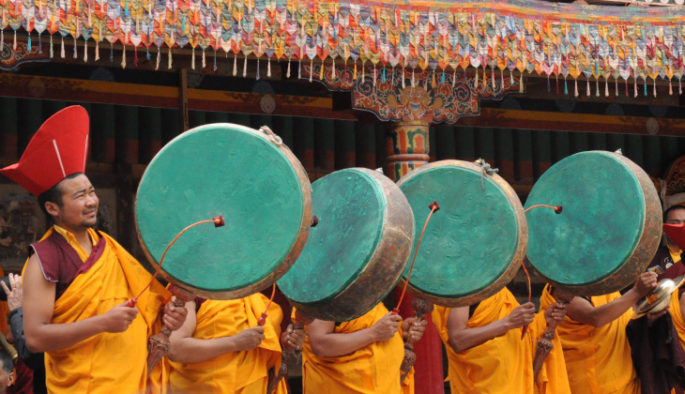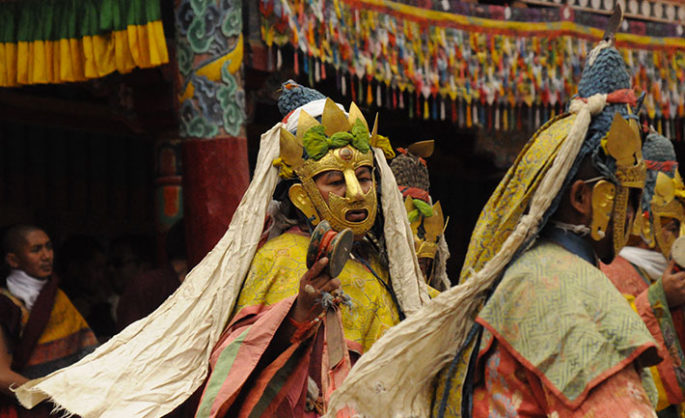
According to a local Ladakh periodical reporting on the Hemis Festival, “His Eminence Thuksras Rinpoche said ‘Hemis festival marks the celebration of the birth anniversary of Guru Padmasambhava, who has emitted immense light and flourished the Vajrayana teachings. We don’t have a chance to receive a direct blessing of Guru Padmasambhava in person but on this auspicious occasion, through mask dance, the activities of Guru Padmasambhava is enacted to bless the people and to bring peace and prosperity.’”
The village of Hemis and its population of 400 is cradled in the auspicious mountains of North India. Hemis is located in the region of Ladakh, a union territory and part of the larger region of Kashmir under dispute by Pakistan, India, and China. Ladakh, where Sacred Earth Journeys will hold a journey in 2021, is geographically phenomenal. Our journey leader, spiritual author and activist Andrew Harvey, wrote in his book A Journey to Ladakh: “Nothing I had read or imagined prepared me for the splendour of the mountains. . .That was the first gift Ladakh gave me.” It is on the highest plateau in India and begs the attention of travelers with its 10,000 elevation, green pine mountains, and otherworldly rivers that run through chilly mars-like landscape.
Arriving in Ladakh, especially in early summer (when Sacred Earth Journeys will be journeying there) the curious traveler is automatically drawn to Hemis for its monastery first established in the Middle Ages and then re-established by the Tibetan-Buddhist Drukpa lineage in the 17th-century. Pilgrims to the monastery take refuge at the statue of Padmasambhava inside the building. Padmasambhava, an 8th-century Buddhist master who introduced Tantric Buddhism to Tibet, is the primary driving force behind the annual Hemis Festival hosted at the monastery.

Upon hearing about the festival, travelers flock to Hemis and are bound in wonder over what’s so special about the festival’s dancing, imagery, rituals, dress, masks, and entrancing music. “It is becoming very popular for tourists to enjoy,” Thuksey Rinpoche told The Economic Times. Thuksey Rinpoche heads the festival, and we’ll be lucky enough to meet and be with him on our journey.
Anyway, here are the 3 main important components of the festival, as well as details of their enticing imagery, symbolism, and other cultural significances.
1. Celebrating Padmasambhava, or, “The Second Buddha”

Why does Padmasambhava get to be a “The Second Buddha” and why is Hemis Festival hosted in part to celebrate his birthday?
This man, this holy Buddhist monk, was and still is a very special figure to the Tibetan Buddhists. He’s often coined as the founder of the oldest of the four major schools of Tibetan Buddhism: the Nyingma school.
Padmasambhava is said to have lived to improve the spiritual condition of all living beings. Legend has it his birth was predicted by Siddhārtha Gautama (the original 5th-century BCE Buddha) to be on the 10th day of the 5th month of the Monkey Year. Contemporary Buddhists ascribe him to the Vajra Guru Mantra, which goes “Om Ah Hum Vajra Guru Padma Siddhi Hum.” The prayer evokes communion with the Three Vajras, those being the purity of action, speech, and thought.
According to The Story of Tibet by American Journalist of Tibetan culture, Thomas Laird, Padmasambhava hid important teachings throughout lakes, caves, fields, and forests of the Himalayas to be found by future spiritual seekers. One of these treasures was the now-famous Tibetan Book of the Dead found by Karma Lingpa.
2. Seeing the Cham Dances

Tibetan Buddhist Cham Dances are meditative dances and offerings to deities. Buddhist performers wear lively masks and traditional costumes to perform the dances accompanied by traditional Tibetan instruments and songs.
At Hemis Festival specifically, the dances are dedicated to Lord Padmasambhava. The dances begin with the Four Goma or Gate Keepers, usually a trio, who dance in colorful masks and dress in order to bind evil spirits, rendering them unable to escape the sacred arena.
Then come the twelve Zhing (Dharmapalas) who are the guardians of the truth. They protect the Buddha’s teachings from evil influence. These dancers have even more vibrant dress and masks and hats with protruding flags.
Next, the Five Chemchog Haruka come to dance. These dancers are the embodiment of Padmasambhava. These dancers work to eliminate any evils working against the peace of sanctioned beings in order to liberate them into a purer land.
The Lords of the Graveyards wear skeletal-looking masks and perform joyous dances to summon the evil forces working against important Buddhist teachings represented by the Dharma. The dance also celebrates the triumph of good over evil. The dancers can be seen hopping on one leg while spinning in circles to the sound of traditional Tibetan percussion and wind instruments.
Finally, what’s often considered the most important sacred dance of the entire festival, is often referred to as “Setting Limits,” as the dancers establish what they consider a physical horizon to keep away entities from invading the sacred arena. . .
Overall, the Cham Dances display important tantric components of Tibetan Buddhism, including ritual, sound, imagery and other symbolisms that utilize the senses in order to accomplish shifts in the mind or energy of an area, in the case of the Cham Dances, the sacred arena in which the dancing is performed. The second day of Hemis Festival is best for experiencing the Cham Dancing. The dancing is stimulating and tends to completely draw in onlookers. The rhythms of the musicians are entrancing as the dancers take the stage.
3. Experiencing the Merchant Stalls
Finally, the merchant stalls. You’ll see goods ranging from handicrafts, jewelry, incense, gemstones, hand-woven baskets, paintings, native Tibetan goods, and much, much more.
While browsing the stalls, it’s also a good time the try the traditional Chang drink. Chang is a Tibetan wine prepared from rice water and only contains very tiny amounts of alcohol. The drink won’t make festival-goers lose their minds, but will only provide them with a little bit of extra “umph” to enjoy the long days of Hemis Festival and Cham Dances.

On day 7 of our Ladakh Journey, we have the honor of witnessing the Hemis Festival. We will be enchanted by the monks wearing their long, colorful costumes and elaborate masks. Yes, we will see them performing Cham Dances to the music of drums, cymbals and wind instruments; a visual portrayal of the triumph of good over evil.

